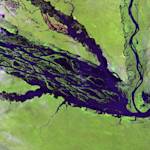Sinharaja Forest
1875 CE • Sri Lanka
Established originally in 1875, the "Sinharaja Forest Reserve is situated in the south-west lowland wet zone of Sri Lanka, ranging in altitude from 300 to 1,170m. Although it is a comparatively small area (89 km2), it is important as one of the last remaining fragments of (relatively) undisturbed lowland forest in Sri Lanka, providing habitat for a high proportion of the island’s unique fauna and flora. For example, Sinharaja supports more than 90% of Sri Lanka’s 26 endemic bird species, and 75% of the country’s 20 endemic mammals. Many of the tree species protected within this small reserve are highly threatened by forest destruction elsewhere on the island, so Sinharaja represents the ‘best chance’ to ensure their long-term conservation. Sixty percent of the tree species recorded at Sinharaja is found only in Sri Lanka, while more than 90% of its Dipterocarp trees are endemic to the island . . . The site is an icon of biodiversity conservation in Sri Lanka, which has led to a considerable increase in conservation awareness among the general public. However, existing conservation issues such as encroachment of forest due to agricultural expansion (e.g., tea plantations), human dwellings and fragmentation due to road construction could seriously compromise the conservation of the world heritage site in the future."
"Sinharaja Forest Reserve," Natural World Heritage Sites.
Image: Dan Lundberg, CC BY-SA 2.0, via Wikimedia Commons


Learn about Maya Lin’s fifth and final memorial: a multi-platform science based artwork that presents an ecological history of our world - past, present, and future.

Discover ecological histories and stories of former abundance, loss, and recovery on the map of memory.

Learn how we can reduce our emissions and protect and restore species and habitats – around the world.

See how art can help us rethink the problems we face, and give us hope that each one of us can make a difference.

Help make a global memorial something personal and close to home. Share your stories of the natural world.


